| Article ID | Journal | Published Year | Pages | File Type |
|---|---|---|---|---|
| 6835158 | Computers & Education | 2014 | 16 Pages |
Abstract
This study explored what social interactions students exhibited during collaborative learning, and analyzed how the social interactions evolved in a computer-supported collaborative learning (CSCL) environment. Six groups (n = 28) from an undergraduate online course were observed during a semester. Students' interactions were analyzed in two perspectives: group regulation and socioemotional. Cluster analysis was conducted to identify collaboration patterns of the groups. The analysis identified three collaborator clusters: one good and two poor. The good collaborators (named Early Active Collaborator) demonstrated: (1) intensive interactions among group members in the early collaboration phase, (2) positive socio-emotional interactions continuously, and (3) adaptive selections of group regulatory behaviors. The others showed dormant interactions throughout the projects and least socio-emotional interactions (named Passive Task-oriented Collaborator) and did not coordinate group process in a timely manner (named Late Collaborator). Comparisons of the interaction pattern and instructor intervention were discussed.
Keywords
Related Topics
Social Sciences and Humanities
Social Sciences
Education
Authors
Kyungbin Kwon, Ying-Hsiu Liu, LaShaune P. Johnson,
